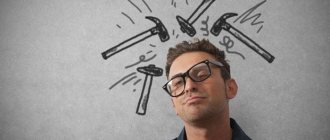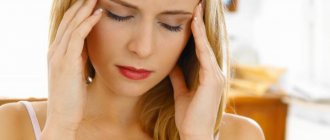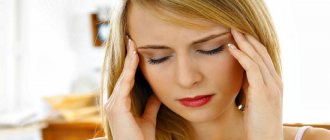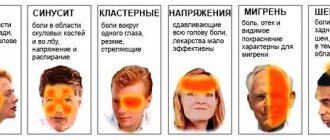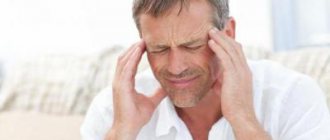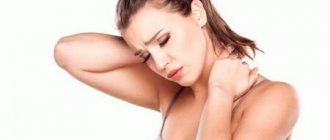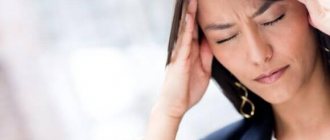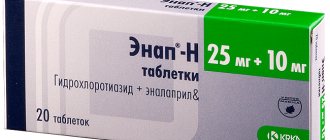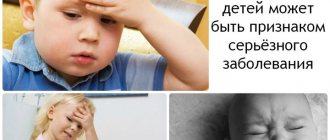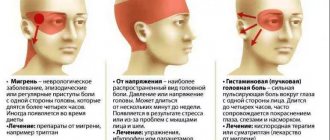Painful symptoms in the head can take many forms. One of them is a throbbing headache, which most often indicates vascular dysfunction. A knocking sensation appears in the back of the head, temples, face and forehead. During the examination, the specialist needs to find out the location of the pain. Depending on this, a diagnosis is made.
Causes, diseases and provoking factors
Pulsation in the head can occur as a result of many provoking factors and indicate the development of serious diseases in the body, causes and diseases that can cause unpleasant painful sensations:
- Aneurysm. The most common cause of discomfort. A rupture of an aneurysm can cause bleeding into the brain and lead to death. In most cases, aneurysm is diagnosed in the female half of the population. Patients feel it as pulsation in the back of the head and noise throughout the head. Occurs as a result of deformation of the cerebral artery.
- Atherosclerosis of the cerebral arteries. At the initial stage of this disease, the patient experiences pulsation, which is caused by plaques in the arteries. Plaques obstruct blood flow and cause noise in the head.
- Intracranial hypertension. Narrowed blood vessels block normal blood flow. The higher the patient's pressure, the more intense the pulsation and noise in the head will be.
- Kidney diseases. Requires preventive measures. In this situation, pulsation without pain is provoked by a large volume of blood that circulates through the cerebral arteries.
- Osteochondrosis of the cervical spine. With this pathology, the patient experiences pulsation in the back of the head or parietal region. This condition is caused by compression of the vertebral artery, resulting in impaired blood flow.
- Diseases of the organs of vision. In this situation, the pulsation becomes pathological and is localized in the frontal and temporal parts. It occurs as a result of increased pressure inside the eyeball.
- Neoplasms in the brain. In most cases, an increase in throbbing pain indicates the development of a tumor. This condition is provoked by the pressure of formation on the blood vessels of the brain.
- Stressful situations and physical activity. The pulsation occurs as a result of a strong blood flow, which provokes a spasm of the arteries.
- Vegetative-vascular dystonia. Pulsation in this disease can be provoked by other concomitant pathologies, stress and strain.
Above, not all the reasons that can cause discomfort in the patient’s head were presented, but only the most basic ones. To accurately determine the provoking factor, you need to contact a specialist.
How to get rid of migraine attacks
To eliminate unpleasant discomfort, you need to find out why the right side of your head hurts. Migraine is very difficult to treat, but complex therapy will help improve the pathological condition and prevent loss of ability to work. But it should be taken into account that only a specialist can prescribe competent treatment based on diagnostics and tests.
Sleep is the best medicine
Some patients also encounter another situation - attacks occur during rest, and after waking up the patient feels significant discomfort. Such symptoms can be treated with painkillers. However, their effect is short-lived.
After a certain period of time, the patient’s body stops accepting potent drugs, and the painful sensations gradually intensify. Therefore, experts recommend combining medications to treat the pathological condition.
Causes
Throbbing pain localized in the head can be primary or secondary. In the first case, it is an independent disease, in the second it is a symptom of a primary pathology. Examples of primary pain accompanied by throbbing in the head are migraine, post-traumatic cephalgia. The main reasons for the development of the secondary form of cephalgia:
- Volumetric intracranial processes (tumors, cysts, foci of hemorrhage).
- Hydrocephalus, increased intracranial pressure.
- Concussion, head injuries.
- Stroke. Cerebrovascular accident, often caused by vascular pathologies (usually atherosclerosis).
- Uncontrolled use of analgesics and other medications (abusive, drug-dependent cephalgia).
Pathologies of the central nervous system, cardiovascular system, and musculoskeletal system can provoke a condition when sharp pains in the head of a pulsating type occur. If pain and pulsation in the head continue for several days, medical consultation with a neurologist, cardiologist, or orthopedic traumatologist is necessary. It is worth paying attention to the accompanying symptoms that indicate the presence of the disease and the severity of the condition.
These include numbness of the limbs, impaired motor coordination, visual dysfunction (darkening, double vision, the appearance of foreign objects in the field of view), convulsive syndrome. Such symptoms indicate the development of a neurological deficit, which can correlate with health and life-threatening pathologies such as stroke (hemorrhagic, ischemic), tumors, and central nervous system infections (meningitis, encephalitis).
Migraine
The head hurts and pulsates in the area where the focus of cephalgia is located - a symptom typical of migraine. Migraine attacks are characterized by unilateral localization of pain. Other symptoms: nausea, vomiting, increased sensitivity to light and sound stimuli. Often attacks of cephalgia develop under the influence of provoking factors:
- Physical, nervous fatigue.
- Lack, excess sleep.
- Food consumption – chocolate, cheese, nuts, citrus fruits.
- Drinking drinks - coffee, red wine, energy drinks, soda containing caffeine.
With migraine, the pulse in the head is clearly heard, which correlates with the participation of vascular factors in pathogenesis. Dysregulation of the tone of the vascular walls provokes a condition when the cerebral arteries first strongly narrow, then sharply expand, which causes severe pain of a pulsating type in the right or left side of the head.
Overuse pain
When there is frequent pulsation in the head and pain occurs in any side of the skull, there is a high probability of developing abusive cephalgia. This type of pain occurs in patients suffering from chronic migraines or other forms of primary head pain. Painful sensations develop in response to prolonged use of analgesics or are associated with their withdrawal.
Frequent use of analgesic drugs leads to the transformation of migraine into an abusive form. The onset manifestations resemble migraine, with the difference that the number of cephalgic attacks increases. Single attacks become more frequent, occur daily, and are chronic. Painful sensations are constantly present, periodically intensifying in attacks.
Symptoms: throbbing pain of migraine or pressing type. May be accompanied by increased sensitivity to light and sound stimuli, nausea, and vomiting. The effectiveness of painkillers used to relieve an attack is constantly decreasing, which necessitates the need to increase the dose.
The post-traumatic form includes painful sensations that appear after a traumatic brain injury and continue for at least 3 months. This type of cephalgia is detected in 30-90% of patients who have suffered a TBI. Psychological disorders and excessive amounts of analgesic medications taken are the leading factors in the formation of post-traumatic cephalgia.
Psychological disorders arise against the background of severe physical and psycho-emotional stress, which accompany any damage to the bone structures of the skull and brain matter. If you have a history of TBI, or a strong pulsation in your head regularly occurs, you need to make an appointment with a neurologist, who will tell you what to do. It is worth paying attention to the accompanying symptoms:
- Sleep disturbance.
- Decreased social motivation.
- Emotional lability, mood swings.
- Increased irritability.
- Psychomotor agitation, anxiety.
- Deterioration of memory and ability to concentrate.
- Transient episodes of dizziness.
- Asthenia (weakness, fatigue).
The pathogenesis is based on structural defects of the central nervous system (damage to diffuse type axons, dysregulation of nociceptive mechanisms, disorder of cerebral hemodynamics). Influencing factors: disruption of the production and metabolism of neurotransmitters (serotonin, catecholamine), neuropeptides, amino acids with an exciting effect.
An increase in blood pressure often causes a condition where there is throbbing in the head with or without pain. A persistent increase in blood pressure is caused by heart and vascular diseases, chronic kidney pathologies, and aldosteronism (increased production of aldosterone by the adrenal cortex).
Swelling in the face and feet often indicates the presence of renal failure and arterial hypertension. Other signs: the appearance of foreign objects (“spots”, dots) in the field of view, shortness of breath, difficulty breathing, transient dizziness. Pulsation in the head without pain is a characteristic sign that indicates that blood pressure has increased.
Pulsation in the head at normal pressure can be observed due to increased contractions of the heart walls. An increase in heart rate often occurs due to a lack of moisture in the body. After long-term sports training, walking on the street against the background of increased sweating, the amount of moisture in the body decreases, tissue dehydration occurs and the volume of physiological fluids (blood, urine) decreases.
To overcome the state of hypovolemia (decreased blood volume), the heart begins to contract intensely, which causes a sensation of pulsation in the head. To correct the situation, just drink clean water (you can add a few drops of lemon juice) and green tea.
Acute, throbbing pain in the head, aggravated by movement, develops as a result of impaired cerebral blood flow against the background of pathologies of the cerebral circulatory system:
- Vegetative-vascular dystonia. Associated symptoms: increased fatigue, decreased performance, nausea, dizziness, shortness of breath, feeling of lack of air.
- Atherosclerotic (formation of plaques on the walls), thrombotic (formation of blood clots) vascular damage. Associated symptoms: facial asymmetry, deterioration of cognitive abilities (memory, mental activity), visual and speech dysfunction.
- Stroke. Associated symptoms: decreased tone of facial muscles (lack of facial expressions), speech impairment, visual dysfunction, weakness, numbness of the limbs in one half of the body.
If it begins to “tick” in the skull area and signs of acute cerebral blood flow disturbance appear, you need to urgently call an ambulance. Stroke threatens health and often causes disability and death of the patient.
Neuritis
Neuritis is an inflammatory process that can cause a condition where there is pounding in the head if it affects the cranial (facial, occipital) nerves, which causes the localization of cephalgia in the skull area. Associated symptoms: paresthesia (sensitivity disorder) in the area of the affected nerve, weakening of the tone of the facial muscles, paresis, paralysis of the facial muscles, manifested by an asymmetrical position of the right and left halves of the face.
Neurosis
To find out why you can hear blood pulsating in your head, you need to make an appointment with a neurologist. If you often hear a pounding in your head and feel like you have a headache, the symptoms may be caused by a neurotic disorder. It is worth paying attention to accompanying signs - pain in the heart and abdomen, decreased performance, increased fatigue, loss of appetite, anxiety, irritability.
Typically, the pathology is manifested by disruptions in the functioning of the autonomic nervous system - increased sweating, accelerated heart rate, changes in blood pressure, and frequent urge to urinate. To eliminate the sensation when the patient feels a pulse in the head on the left or right, as well as accompanying symptoms, treatment is prescribed. To get rid of mental disorder, cognitive behavioral psychotherapy is used.
A throbbing headache in the back of the head often indicates osteochondrosis in the cervical spine. The pathology is a degenerative process that affects the cartilage and bone structures of the spine, forming the intervertebral discs. Degenerative-dystrophic changes in tissue lead to changes in the shape of the vertebrae, which, if the neck moves unsuccessfully or sharply turns the head, can compress the vertebral arteries.
The reasons for the sensation of pulsating in the back of the head are associated with compression of the vessels supplying the brain. Spondylosis or arthrosis are diseases of the bone and joint tissue of the spinal column, which are characterized by the formation of osteophytes (pathological growths on bone tissue).
The mechanism of occurrence of pulsating cephalgia in the left or right occipital part of the head is identical to the pathogenesis of headaches with osteochondrosis. Painful sensations when the patient feels pulsating and pounding in the back of the skull are associated with compression of the blood vessels.
Associated symptoms depending on the cause
Throbbing and aching in the head can be accompanied by various symptoms and characteristic signs, which in most cases will depend on the provoking cause:
- with migraine, the head pulse occurs directly on one side of the head, this condition is necessarily accompanied by severe pain, nausea, increased sensitivity to various irritants, weakness and dizziness;
- in atherosclerosis it is accompanied by pain, which becomes dull and pressing as the disease progresses;
- for colds and inflammatory diseases is accompanied by corresponding symptoms;
- with glaucoma, the pulse in the head is accompanied by impaired visual function and pain;
- with tumors, the patient in the morning experiences not only intense pulsation in the head, but also nausea, vomiting, drowsiness and unreasonable fatigue;
- for diseases of the oral cavity, this condition is considered a concomitant symptom and is accompanied by other signs of pathologies;
- with osteochondrosis of the cervical spine, the patient simultaneously experiences pain in this area of the spine, tinnitus, darkening of the eyes and loss of coordination;
- with cervical migraine, the patient also experiences pain in the occipital region on one side and impaired perception.
Health care
Treatment is prescribed by a specialist after a thorough examination. In most cases, treatment methods will depend on the triggering factor.
Properly prescribed therapy will help get rid of the pulse in the head and the underlying disease. To get rid of pulsation in the head, you should go through several steps:
- Optimizing the period of work and rest, eliminating stressful situations. Rejection of bad habits. These recommendations help get rid of one-time and minor pulsation. If necessary, you can take sedatives, but only after consulting your doctor.
- Therapy of the main provoking disease. Treatment is prescribed after a thorough examination. Having gotten rid of the provoking factor, the noise, pain and aches in the head will disappear. If necessary, surgical intervention is performed, for example, to remove a tumor.
- Physiotherapy and massage. Conducted in a hospital as prescribed by a doctor. No more than 15-20 sessions are recommended.
- It is also recommended to attend physical therapy sessions and perform exercises at home, which will not only improve your well-being and blood flow, but also strengthen your muscles.
- The use of herbs and infusions that help get rid of spasms and stress. It is recommended to drink ginger tea, infusion of strawberry flowers, valerian or dandelion. Before starting treatment with folk remedies, you should consult your doctor and take into account the body’s reaction to individual components, if any.
For glaucoma, in order to get rid of pulsation and the underlying pathology, it is recommended to take drugs such as Proxofelin, Kosopt, Fotil and others. At the last stage of the disease, surgical intervention is mandatory.
If you have a migraine, you should wrap your head in a warm towel. You can also take medications: Spasmalgon, Farmadol, Citramon, Copacil and others.
If you have high blood pressure, you should take medications that lower your blood pressure levels to normal. These remedies are prescribed exclusively by a specialist.
You should not ignore this condition and constantly take painkillers, since by masking the symptoms, you worsen the situation and give time for the provoking factor to progress.
Prevention of pulsation and accompanying symptoms consists of timely detection and treatment of provoking concomitant diseases.
It is also recommended to lead a healthy lifestyle and eat right, give up bad habits and exclude self-treatment, which can only aggravate the condition and situation.
Strong throbbing in the head cannot be tolerated. As soon as acute and persistent discomfort appears, it is necessary to urgently call an ambulance. Before the arrival of qualified doctors, you need to provide first aid yourself. What is needed for this?
- Take painkiller medications - Paracetamol, Ibuprofen, Analgin, Nimesulide, Nurofen, etc.
- Take a horizontal body position, while preferably raising your legs to a slight elevation. It is important not to tilt your head down.
- Calm down and remove all sources of irritation from the room (noise, bright light, etc.).
- If you have a headache, apply a cold compress to the sore spot. This method helps relieve acute pain.
- If your physical condition allows, then take a contrast shower or bath with a decoction of soothing herbs (melissa, mint, chamomile).
- Eliminate bad habits - do not smoke, do not drink alcohol.
- Drink a glass of herbal tea based on oak bark or chamomile and mint.
- Perform a gentle massage of the neck and head.
Diagnostics
If your head regularly throbs strongly, you need to make an appointment with a doctor, who will prescribe a diagnostic examination and tell you what to do. Taking an anamnesis is the first priority diagnostic measure. The main methods of hardware diagnostics that are used to identify the causes of cephalgia and the sensation of a pulse in the head:
- MRI, CT.
- Angiography.
- Electrocardiography.
- Electroencephalography.
- Vascular ultrasound.
A comprehensive examination allows us to identify the causes of violations. Neuroimaging in MRI and CT format shows the state of brain structures - elements of the circulatory and liquor systems, gray and white matter, the presence of cysts, tumors, and areas of hemorrhage.
Treatment at home
If a person has a pulsating and noisy head, then very often folk remedies are used, which are quite effective for this condition.
At the same time, it is worth taking medications, which are considered the basis of therapy for these and similar conditions. But, if the patient suffers from these types of headaches, and there is no way to see a doctor, you can resort to one of these methods:
- Using leech saliva.
- Ginger based tea. You will need two teaspoons of ginger in any form and a liter of boiled water. It is necessary to simmer the drink over low heat for several minutes. After cooling, it is recommended to add honey or lemon to the tea. You need to drink at least twice a day.
- Chopped horseradish root is mixed with sour cream (1:1). It is recommended to take at least three times a day.
- Tea prepared from strawberry flowers, which can be consumed in unlimited quantities.
- Milk with iodine will help get rid of pulsation. To do this, you need to mix two drops of iodine with a glass of milk. The course of treatment is 20 days. With each dose it is necessary to increase the drops by one; on the 11th day the number of drops is reduced one by one. Break 14 days.
- Dandelions with sugar. To prepare the product, you need 2 kg of dandelions, which are poured into a three-liter container in layers with sugar. Approximately raw materials are used 1:1. The mass must be compacted at the end and hidden for three days in a dark place. The resulting syrup is taken 1 tsp. per 100 ml of liquid, no more than three times a day.
- Valerian root helps calm pulsation. For a glass of water you need to use 1 tbsp. plants. Leave for 8 hours. Drink 2-4 times a day.
Traditional methods are successfully used in the treatment of pulsation in the head. They are used in addition to medications and are also used as primary treatment.
- Hirudotherapy. Leech saliva contains components that thin the blood and improve its circulation through the vessels.
- Ginger tea. A couple of teaspoons of ginger (fresh, grated) are brewed with a liter of boiling water and simmered on fire for 10 minutes. After the broth has cooled, you can add honey, lemon, and drink this delicious medicinal drink 2-3 times a day.
- Horseradish root. Grind the fresh root of the plant well using a blender. Table. Take a spoonful of the product mixed with sour cream in equal proportions 3 times a day.
- Strawberry flower tea helps with throbbing headaches. You can drink it unlimitedly; the product relieves spasms in the head.
- An interesting remedy that is made from iodine and milk. Two drops of regular pharmaceutical iodine are dripped into a glass of milk. Take this mixture for 10 days, increasing the amount of iodine by one drop each day. After 10 days, the amount of iodine is reduced according to the same principle. Take a break of two weeks and start the course of treatment again.
- Immerse 200 g of chopped garlic in a glass of vodka. Leave in a dark place for two weeks, strain after time. Add honey and propolis there, two per tablespoon. l., let it brew for another three days. Take this way three times a day: add a drop of tincture to a glass of milk. Use daily, increasing the number of drops of tincture by one every day. Treatment lasts 25 days.
- Take mulberry branches, young shoots, chop. Throw a handful of raw materials into a saucepan, pour in a liter of boiling water, and simmer for another 10 minutes over low heat. Infuse the decoction for about an hour and drink a glass of it three times a day.
- Pour two kilograms of yellow dandelion flowers (you can take more) into a three-liter jar in layers of sugar: the first layer is flowers, the second is sugar, and so on. For a kilogram of flowers you need to take about two kilograms of sugar. It is good to trample the mass so that the flowers release juice. Hide the jar in a dark place for three days, then take the resulting syrup one teaspoon at a time, dissolving it in 100 g of water, three times a day.
- The following herbal mixture helps well: motherwort grass (4 parts), mint (1 part), hawthorn and rose hip berries, chamomile flowers. Brew and drink as tea on the table. take a spoonful of the mixture and a glass of water.
- Valerian infusion: table. a spoonful of plant root is poured into a glass of clean water at room temperature. After 8 hours, the infusion is ready and can be consumed up to 4 times a day.
Throbbing in the head is a common symptom of prolonged stress. Fatigue and nervous tension accumulated over the years can cause this symptom. Despite the fact that the fast pace of life is a circumstance that a modern person must come to terms with, it is necessary to find time for proper rest. There are enough relaxation techniques known, using which you can combat negative environmental factors.
How to reduce sharp and sharp throbbing pain
Cephalgia can manifest itself in different ways.
But a throbbing headache is one of its most unpleasant types. It significantly worsens the quality of life. In addition, it is often a dangerous symptom, indicating the development of serious pathologies. By its nature, a throbbing headache can be:
- weak, barely perceptible. As a rule, such a symptom is associated with a slight deterioration in health for various reasons;
- short-term, but sharp. Sometimes such pain occurs after drinking caffeinated drinks against a background of high blood pressure;
- long-term, exhausting, varying in intensity. As a rule, in this case, pain is associated with severe fatigue or the presence of concomitant diseases.
Painful pulsations can be felt in different parts of the head. Since the obvious cause of this pain syndrome is problems with blood vessels, the pain can radiate to any area of the skull.
A throbbing headache always causes significant discomfort. Therefore, it is not recommended to tolerate it. If the pain occurs suddenly due to fatigue, nervous strain, acute respiratory viral infection or flu, then you can independently reduce its intensity with the help of painkillers.
The following types of drugs are considered effective:
- non-steroidal anti-inflammatory drugs. These include Citramon, Ibuprofen, Paracetamol, Pentalgin, etc.;
- antispasmodics. The most famous are such drugs as No-shpa, Spazmalgon, Spazgan. These tablets can quickly relieve vascular spasms, which reduces pain;
- antimigraine medications. These include Sumatriptan, Imigran, Zomig. With their help you can relieve the throbbing pain of a migraine.
Before taking painkillers, you must carefully read the instructions for use. It should be remembered that an overdose of these drugs is unacceptable.
Traditional methods are effective for relieving throbbing pain in the head. If you feel overworked and feel tired, which may be accompanied by a throbbing headache, it is recommended to brew a strong drink from black and green tea leaves. It is recommended to add a sprig of mint to the cup. After this, this drink can be drunk warm. The throbbing pain in the head will decrease or disappear in about a quarter of an hour.
Alcohol tinctures of herbs help reduce pain if used in the form of compresses. It is necessary to pour 100 ml of vodka or alcohol into 3 tablespoons of the mixture, which includes peppermint leaves, lemon balm and crushed coriander fruits in equal proportions. The mixture should be infused for several days in a tightly closed bottle.
Essential oils used in aromatherapy help reduce pain. If throbbing pain in the head occurs frequently as a reaction to stressful situations, then traditional healers recommend including honey in the diet if you are not allergic to it.
If the throbbing pain in the head does not decrease after taking painkillers or using folk remedies, then you should consult a doctor. It is very important to do this as quickly as possible in cases where throbbing pain in the head is accompanied by additional symptoms. In such cases, treatment can be prescribed only after examination.
Prevention
If there is a pulsation in the head, this may be associated with the development of a tumor process, which requires urgent diagnosis and correct treatment. If cephalgia, accompanied by pulsation, occurs due to external factors, attacks can be corrected. To prevent the development of conditions when a headache occurs and pulsates in the skull, doctors recommend adhering to the following rules:
- Avoid abuse of alcoholic and caffeinated drinks.
- Arrange a sleeping place (orthopedic mattress, comfortable pillow).
- Organize a workplace (a comfortable chair with a high back, the correct location of the computer monitor relative to the direction of view).
- Take breaks and warm up during long periods of work at the computer.
- Avoid hypothermia in the neck, head, and feet.
- Avoid stressful situations.
- Lead an active lifestyle and play sports.
A severe throbbing headache, localized on the left, right or diffusely, can occur due to a lack of fresh air (indoors, a bathhouse), excessive mental and physical stress, and fasting. To prevent unpleasant symptoms, provoking factors should be avoided.
The causes of severe throbbing in the head with and without pain vary significantly. A doctor can make an accurate diagnosis based on the results of a diagnostic examination.
Content
- Headache in the back of the head
- Head and eyes hurt
- Headache and fever
- Headache and nausea
- Headache during pregnancy
- Headache in temples
- Headache and dizziness
- Headache while breastfeeding
- Headache MISCELLANEOUS
- Headaches with osteochondrosis
- Blood pressure and headaches
- What can cause a headache?
- Brain cyst
- Nursing mother with headache
- Brain treatment
- Painkillers for headaches
- Brain tumor
- Why does my head hurt?
- Strong headache
- Headache tablets
- Fever and headache
- The child has a headache
- Frequent headaches
- What to do if you have a headache
- Encephalopathy
Other articles:
| One of the most pleasant and popular points for more… |
| Let's learn useful things together Products with high content You can further... |
| Periventricular encephalotopia Today, among medical reports, more... |
Popular
| Is cerebral encephalopathy curable or not (7) |
| Brain tumor in a child forum (6) |
| Arachnoid cyst of the brain in the fetus (6) |
| Asd for brain tumor (6) |
| Headache on the right side of the head and temple (5) |
| Residual encephalopathy with cognitive impairment (4) |
You might be interested in:
| Headache? Don't stress! Hardly further in the world... |
| Sinus headaches Sinuses are air more... |
| Why do you get a headache after drinking alcohol? With the term “hangover”, further... |

